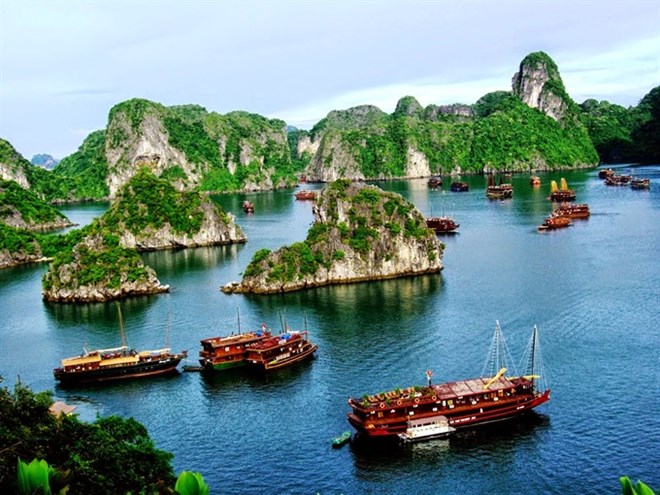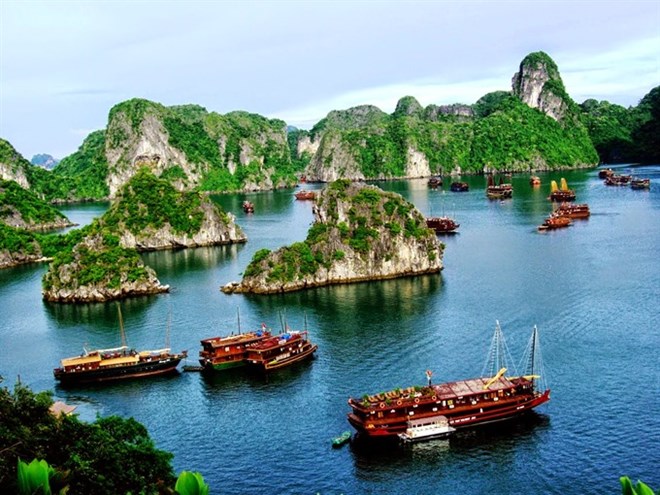
Preservation of cultural and natural heritage sites plays an important role in tourism growth in Vietnam, experts said at a conference on November 30 in HCM City.
The UNESCO-recognised world
heritage site Ha Long Bay welcomed 6.9 million visitors last year, earning
nearly 10.8 trillion VND (463 million USD) in revenue. — (Source:
chudu24h.com)
Vo Van Thanh of the Southern Institute of
Social Sciences (SISS), said thanks to tourism, protection, conservation and
restoration of world heritage sites were improved.
"In Vietnam, heritage tourism activities have contributed to introducing
the country’s World Heritage sites,” he said.
The conference, which discussed the opportunities and challenges for cultural
heritage values, was organised by the HCM City University of Culture in
collaboration with SISS, the HCM City Institute for Development Issues, and the
International Centre for the Study of the Preservation and Restoration of
Cultural Property (ICCROM).
More than 300 cultural experts and researchers from Vietnam and abroad took
part in the event.
Preservation of heritage sites has helped create jobs and improved living
standards in local communities, Thanh said.
Last year, heritage sites brought a high level of visitors and revenue from
ticket sales and tourism services, according to the Ministry of Culture, Sports
and Tourism’s Cultural Heritage Department.
Ha Long Bay in Quang Ninh province, for example, welcomed 6.93 million visitors
last year, including 2.9 million foreigners, a year-on-year increase of 12.9
million.
Its tourism revenue reached nearly 10.8 trillion VND (463 million USD), a rise
of 39 percent compared to 2016.
The Hue Citadel welcomed 3 million visitors, including 1.8 million foreigners,
earning 320 billion VND (13.7 million USD) from entrance ticket sales, a
four-time increase compared to 2011.
Nguyen Thi Thu Trang of the cultural heritage department said: "Tourism is
considered a motivating factor to protect cultural and natural heritage sites.
It is one of the most effective means for cultural exchange between Vietnam and
the world.”
Vietnam has eight UNESCO-recognised World Heritage sites and eight
UNESCO-recognised world biosphere reserves.
The World Heritage sites are the Hue Citadel, Ha Long Bay, Hoi An Ancient Town,
My Son Sanctuary, Phong Nha – Ke Bàng National Park, Thang Long Royal Citadel
complex, and Ho Dynasty Citadel.
The biosphere reserves are the Can Gio Mangrove Forest in HCM City, Nam Cat
Tien National Park in Dong Nai and Lam Dong provinces, Cat Ba Archipelago in
Hai Phong city, Hong (Red) River Delta, Kien Giang biosphere reserve in the
Mekong Delta, Cu Lao Cham in Hoi An, Western Nghe An, and Ca Mau Cape in the
southernmost province of Ca Mau.
Source:VNA
The clothing of women reflects the culture of the Muong, Thai, Tay, Dao, and Mong ethnic groups in the northern province of Hoa Binh.
Gongs hold a special place in the cultural and spiritual life of the Muong ethnic people in Hoa Binh province. More than musical instruments, they are an indispensable part of community rituals and collective memory, echoing through generations as a spiritual thread linking the past, present, and future.
Preserving and promoting the cultural values of the Muong ethnic group has become an urgent task in the current context, as many traditional values face the risk of fading away. This effort requires not only protecting the cultural identity but also eliminating outdated customs and developing a modern cultural lifestyle, contributing to sustainable values for the Muong community in Hoa Binh province.
The Muong ethnic culture, deeply rooted in Vietnam’s mountainous north, continues to be preserved and revitalised by dedicated individuals and communities determined to safeguard their ancestral identity.
The Muong group is one of the largest ethnic minorities in Vietnam, primarily found in Hoa Binh province. The Muong people in Hoa Binh boast a rich and diverse cultural treasure that reflects the unique identity of this ethnic group. Accounting for over 63% of the province's population, they have created and preserved numerous distinctive cultural values, contributing to their unique identity. Their cultural heritage is an invaluable asset, at the heart of their national identity, and represents a vibrant spiritual life that must be preserved and promoted in today’s modern world.
For generations, the ethnic communities of Hoa Binh province, particularly the Muong people, have preserved vibrant festivals deeply intertwined with the region’s geography, nature, and social traditions. These celebrations enrich Hoa Binh’s spiritual life and cultural identity, reflecting both folk beliefs and the intermingling of ethnic customs. Many of these festivals have endured the test of time, passed down through generations and continuing to thrive today. Among them, the Khai Ha (Going Down to the Field) festival stands out as one of the most significant events of the Muong ethnic group.



